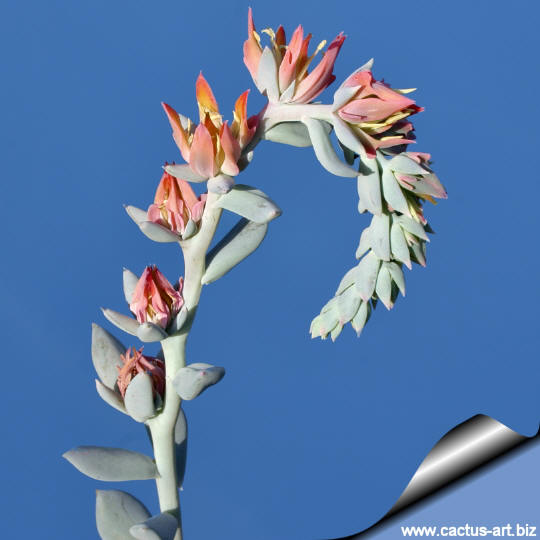|
|
|
Family: Crassulaceae
Scientific name: Echeveria
runyonii 'Topsy Turvy'
Origin: This cultivar is a mutation originated in cultivation in California. The
standard Echeveria runyonii is found natively in Mexico
Etymology: The genus Echeveria is named after the 18th
century Spanish botanist Atanasio Echeverria Codoy.
Common English Names include: Mexican hens
and chicks plant.
There is also a crested form which is Echeveria
runyonii cv. "Topsy-turvy" f. cristata which can be reproduced
only vegetatively. Only a fragment of the crested shoot is is used for
reproduction because leaves and normal shoots (non-crested) do not
produce the crested trait.
NOTE: Echeveria runyonii 'Topsy Turvy' is one of the true
monstrous forms of Echeveria that 'breeds true' and won't revert back to
it's natural form.
|
|
Description: This is an interesting leaf form
of Echeveria runyonii, which is a pale blue to white-blue
leaf Echeveria with normal shaped leaves. However, this 'Topsy Turvy'
form is much more popular, so the 'regular' form is quite rare in
cultivation. It is a profuse offesetter and can create large mounds of
densely crowded plants up to 20 x 35 cm (height by width). Parent plants
can get up to 25 cm across, but rarely do the offsets
Rosettes: Open and relatively untidy. The leaves are too narrow
to form the perfect rosette usually expected in this genus.
Leaves: Up to 7,5 cm long by 2.5 cm across. Blue-green to
silvery-grey often with pink tips, spatulate, strongly inversely keeled
on the lower surface with leaf tips pointing inwards towards the center
of the plant. This leaves are some of the most unique curling and
twisting leaves among the Echeverias, looking as if they are turned
inside out.
Flowers: Showy bright orange, apricot and pink on tall arching
racemes
Blooming season: Usually in late Summer Autumn.
|
|
|
|

The plants bloom in the autumn with tall arching racemes of bright
reddish orange flowers. They are very showy when in bloom.
|
|
Cultivation: it can tolerate sun to shade but - generally speaking -
the more light a plant gets the better it will display its colours and
shape. However, when moving plants from lower light conditions into full
sun, be wary of sun scorch, most easily avoided by ensuring plants are
well-watered before moving them on a cloudy day. They can tolerate
extended dry periods and survive drought without the need for watering,
but they will grow stronger if they receive adequate moisture during
their growing season, ut never allowing the plant to remain waterlogged
(root rot sensitive). Use a very porous soil, which will allow quick
drainage. Slow release fertilisers with a low to moderate nitrogen
content are adequate for the spring and summer growing seasons, and
additional fertiliser applications would not required until spring. Good
air movement is important for minimising pest and disease risks, and
avoiding excessive humidity in cool winter conditions is important to
successfully growing Echeveria in the nursery environment. It can
tolerate light frosts, but it is best overwintered at 5-10 °C.
With the cooler autumn temperatures tending to make their foliage
colours become more intense than those of the active summer growing
season.
Aphids like this plant (and all flowering Echeverias).
Propagation: Echeveria runyonii 'Topsy Turvy' is usually propagated by removal of
offset and by division of large clumps. Let the cut ends dry for
overnight or up to a week before potting up. Some growers recommend
planting immediately into dry growing media, watering only after roots
form.

 |
|